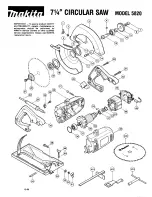
South Bend Tools
For Machines Mfd. Since 10/21
Model SB1122
-25-
O P E R A T I O N
Blade Length
Measured by the blade circumference, blade
lengths are usually unique to the brand of your
bandsaw and the distance between the wheels.
Model
Blade Length
SB1122 .......................................................... 108
1
⁄
4
"
Blade Width
Measured from the back of the blade to the tip of
the blade tooth (the widest point).
Model
Blade Width
SB1122 ............................................................. 1
1
⁄
16
"
Tooth Type
The most common tooth types are described as
follows, and illustrated in Figure 24.
Standard (or Raker)
Variable Pitch (VP)
Variable Pitch Positive Rake
Hook (or Claw)
Skip (or Skip Tooth)
Figure 24. Bandsaw blade tooth types.
Figure 24. Bandsaw blade tooth types.
Standard or Raker:
Equally spaced teeth set at
a "0" rake angle. Recommended for all purpose
use.
Variable Pitch (VP):
Varying gullet depth and
tooth spacing, a "0" rake angle, excellent chip
removing capacity, and smooth cutting.
Blade Pitch (TPI)
The chart below is a basic starting point for
choosing teeth per inch (TPI) for variable pitch
blades and standard raker set bi-metal blades/
HSS blades. However, for exact specifications
of bandsaw blades that are correct for your
operation, contact the blade manufacturer.
To select correct blade pitch:
TOOTH SELECTION
50
2
3
4 5 6 7 8
9
10
11
12
13
14
15
16
17
18
19
2½
3½
75
100
150
200
250
300
350
400
2/3
2/3
2/3
1.4/2.5
1.4/2.5
1.5/.8
1.5/.8
3/4
3/4
3/4
4/6
4/6
5/8
450
mm
inch
Material Width/Diameter
Material Width/Diameter
Material Shapes
Material Shapes
Teeth Per Inch (TPI) for Bandsaw Blades
Teeth Per Inch (TPI) for Bandsaw Blades
Figure 25. General guidelines for blade selection and speed chart.
Figure 25. General guidelines for blade selection and speed chart.
1.
Measure the material thickness. This
measurement is distance from where each
tooth enters workpiece to where it exits
workpiece.
2.
Refer to "Material Width/Diameter" row of
blade selection chart in Figure 25, and read
across to find workpiece thickness you need
to cut.
3.
Refer to "Material Shapes" row and find
shape of material to be cut.
4.
In applicable row, read across to right
and find box where row and column
intersect. Listed in the box is minimum TPI
recommended for variable tooth pitch blades.
The TPI range is represented by a "/"
between numbers. For example, 3/4 TPI is
the same as 3–4 TPI.
The Blade Speed Chart on Page 28 offers
speed guidelines for various metals, given
in feet per minute (FPM). Choose the speed
closest to the number shown in the chart.
Содержание SB1122
Страница 88: ...southbendtools com Printed In Taiwan CS22069 ...
















































